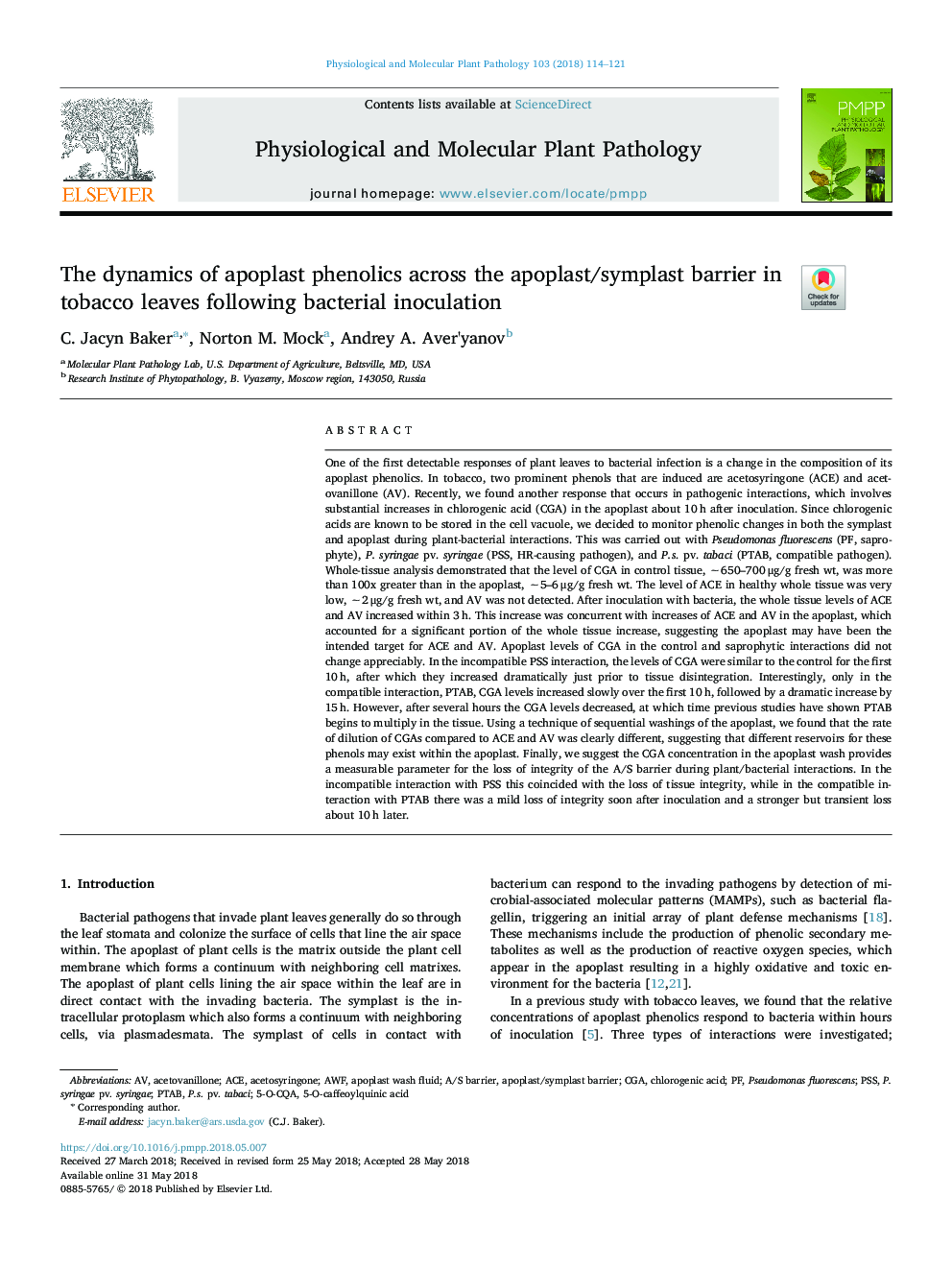| کد مقاله | کد نشریه | سال انتشار | مقاله انگلیسی | نسخه تمام متن |
|---|---|---|---|---|
| 8649191 | 1570836 | 2018 | 8 صفحه PDF | دانلود رایگان |
عنوان انگلیسی مقاله ISI
The dynamics of apoplast phenolics across the apoplast/symplast barrier in tobacco leaves following bacterial inoculation
ترجمه فارسی عنوان
پویایی فنول های آپوپلاست در سراسر مانع آپوپلاست / سمپلست در توتون ها پس از تلقیح باکتری ها
دانلود مقاله + سفارش ترجمه
دانلود مقاله ISI انگلیسی
رایگان برای ایرانیان
کلمات کلیدی
موضوعات مرتبط
علوم زیستی و بیوفناوری
علوم کشاورزی و بیولوژیک
دانش گیاه شناسی
چکیده انگلیسی
One of the first detectable responses of plant leaves to bacterial infection is a change in the composition of its apoplast phenolics. In tobacco, two prominent phenols that are induced are acetosyringone (ACE) and acetovanillone (AV). Recently, we found another response that occurs in pathogenic interactions, which involves substantial increases in chlorogenic acid (CGA) in the apoplast about 10â¯h after inoculation. Since chlorogenic acids are known to be stored in the cell vacuole, we decided to monitor phenolic changes in both the symplast and apoplast during plant-bacterial interactions. This was carried out with Pseudomonas fluorescens (PF, saprophyte), P. syringae pv. syringae (PSS, HR-causing pathogen), and P.s. pv. tabaci (PTAB, compatible pathogen). Whole-tissue analysis demonstrated that the level of CGA in control tissue, â¼650-700â¯Î¼g/g fresh wt, was more than 100x greater than in the apoplast, â¼5-6â¯Î¼g/g fresh wt. The level of ACE in healthy whole tissue was very low, â¼2â¯Î¼g/g fresh wt, and AV was not detected. After inoculation with bacteria, the whole tissue levels of ACE and AV increased within 3â¯h. This increase was concurrent with increases of ACE and AV in the apoplast, which accounted for a significant portion of the whole tissue increase, suggesting the apoplast may have been the intended target for ACE and AV. Apoplast levels of CGA in the control and saprophytic interactions did not change appreciably. In the incompatible PSS interaction, the levels of CGA were similar to the control for the first 10â¯h, after which they increased dramatically just prior to tissue disintegration. Interestingly, only in the compatible interaction, PTAB, CGA levels increased slowly over the first 10â¯h, followed by a dramatic increase by 15â¯h. However, after several hours the CGA levels decreased, at which time previous studies have shown PTAB begins to multiply in the tissue. Using a technique of sequential washings of the apoplast, we found that the rate of dilution of CGAs compared to ACE and AV was clearly different, suggesting that different reservoirs for these phenols may exist within the apoplast. Finally, we suggest the CGA concentration in the apoplast wash provides a measurable parameter for the loss of integrity of the A/S barrier during plant/bacterial interactions. In the incompatible interaction with PSS this coincided with the loss of tissue integrity, while in the compatible interaction with PTAB there was a mild loss of integrity soon after inoculation and a stronger but transient loss about 10â¯h later.
ناشر
Database: Elsevier - ScienceDirect (ساینس دایرکت)
Journal: Physiological and Molecular Plant Pathology - Volume 103, August 2018, Pages 114-121
Journal: Physiological and Molecular Plant Pathology - Volume 103, August 2018, Pages 114-121
نویسندگان
C. Jacyn Baker, Norton M. Mock, Andrey A. Aver'yanov,
